Sida
Sida L.
Family: Malvaceae
Common names: fanpetals, mallows, sidas (Eng.)
Introduction
Sida’s weed-like habit and small flowers keep it away from the popularity enjoyed by its tropical splendour relative, the Hibiscus. The attraction to growing Sida will be mainly for the assortment of herbal medicines derived from the plants.

Description
Description
Members of Sida are herbs, shrubs or many may best be described as suffrutices, where the plants are low, much-branched, woody at the base and herbaceous apically, 0.5 to 1.3 m tall.

They are annual or biennial, sometimes perennial. Stems are long and soft, single and erect or many branched from the base and mostly hairy.

Their simple, alternately arranged leaves are borne on petioles, often shorter than the leaves and with 2, spiny stipules. The leaves in most species are undivided, oval, oblong or lance-shaped, with jagged margins. They are paler below, with short, branched hairs.

Flowers, held on short to long pedicels, are solitary in axils of leaves or form clusters on stem apices. They are 10–20 mm in diameter and in shades of white, yellow and orange, with a darker hue at the base functioning as nectar guides. Each flower has 5 sepals fused at the base (cup-shaped) and may be hairy and 5 free petals, rounded and floppy. There are many, tiny stamens uniting in a short column. One style is present which passes through the staminal column and divides into several branches ending in globular stigmas, usually a darker hue, sometimes red-coloured.
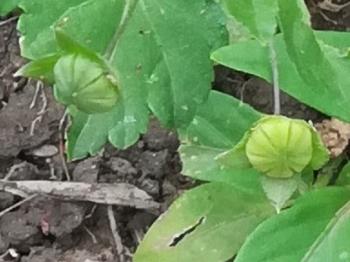
The fruit is a small capsule splitting apart at maturity (schizocarp) into 5 to 12 segments called mericarps, each segment contains 1 seed. Seeds are small, kidney-shaped, brown or black, with 2 sharp awns at the top. Species of Sida flower from October to February, the more common species like S. acuta, S. cordifolia and S. rhombifolia, may flower throughout the year.
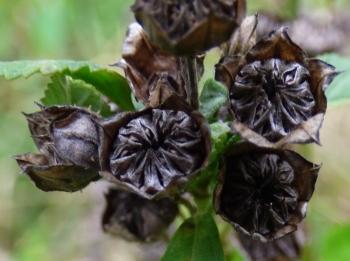
Conservation Status
Status
All species of Sida in southern Africa are classified as Least Concern (LC) in the Red List of South African plants.
Distribution and habitat
Distribution description
Sida is distributed throughout the world, mostly in the tropical and subtropical regions, with species spreading into the temperate areas. Like most members in the family, Sida is concentrated in the New World. There are ± 158 species, some common to continents and spread as follows: Africa (30 species), Asia (50 species), Australia (35 species), North, Central and South America (± 110 species). The genus is considered to have originated in Central America and later spread to other continents. In southern Africa, there are 10 species of Sida, all except S. spinosa also occur in tropical Africa. The genus is concentrated in the summer rainfall region of South Africa, where it occurs along the coast from Cape Town (Western Cape) to the northern border of KwaZulu-Natal, and inland, spreading into Namibia and Botswana. Its occurrence in the Western Cape is restricted to the coast and scarce elsewhere and it is absent from the interior of the Northern Cape.
The most widespread species in South Africa, S. acuta, S. cordifolia and S. rhombifolia are also found in the Americas, tropical Africa, Indian sub-continent and Australia. The species may have been introduced from Central America, becoming naturalised elsewhere and considered part of the indigenous flora, as little is known about the early history of the genus.

Derivation of name and historical aspects
History
Sida is derived from the ancient Greek word sidē which meant ‘plant’. Theophrastus used sidē for a plant growing in marsh areas thought to be an Althaea L., the marshmallow plant that gave the spongy pink and white confectionery, its name. Linnaeus adopted the name from Theophrastus’ writings.
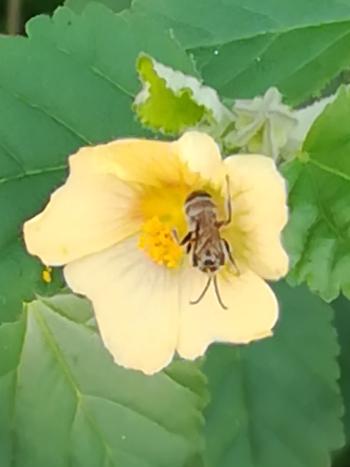
Ecology
Ecology
Flowers in Sida open in the mornings and close by noon. Pollination in the genus is mainly by bees. The colourful flowers also attract wasps and butterflies. Bees visit for pollen and nectar, and wasps and butterflies for nectar only and these were observed in S. acuta, S. cordifolia and S. rhombifolia.
Fruits develop and mature in about 10 days, breaking up into one-seeded segments, the spines of which stick to animal fur and clothes and distribute seeds. Seeds are also light and carried by wind in the dry season or water in the rainy season. Birds were observed to feed on fruit in KwaZulu-Natal species.

Sida are hardy plants and some species have spread widely, becoming naturalised in many countries, and species like S. acuta, have turned weedy and invade agricultural land, causing risk to crops. Because of species inhabiting disturbed open ground, they are referred to as ruderals. Widespread species in South Africa are seen growing in disturbed patches along road sides and forest margins. They appear to be drought tolerant and also can withstand waterlogging in high rainfall areas.
Uses
Use
For many years, Sida species were used in folk remedies in Africa, Brazil and India, places where medicinal plants still plays an important role. The leaves and roots of Sida plants were used mainly for its anti-septic properties to treat fever, wounds, skin infections, conjunctivitis, stomach- and respiratory disorders, and as an anti-inflammatory for rheumatism, cancer and leukemia. Recent studies reported the effects of aqueous extracts from the roots and leaves of Sida species. Extracts from S. cordifolia for example, were shown to have a therapeutic action in Parkinson’s disease and those from S. tuberculata, showed significant antimicrobial effect. S. cordifolia also has a compound called ephedrine used in inducing weight loss. Other uses in Africa, include the leaves of S. cordifolia are cooked as a vegetable and the fibres from stems of S. cordifolia and S. rhombifolia are used in broom- and basket making.

Growing Sida
Grow
Unlike other genera in the Malvaceae, Sida is less important as a garden plant, as flowers are hidden among leaves, due to the short pedicels. However, the taller species can be used in garden beds for their foliage, as well as yellow and orange flowers to attract bees and butterflies. They should be planted among long-lived perennials to provide greenery and blooms over the seasons. Plant sidas in open spots where there is full sun or partial shade, in loam soil that drains well. These plants prefer dry, frost free conditions. Propagation is from seeds and once the seeds germinate, the plants grow quickly. Annual species produce copious amounts of seed.
As Sida seeds germinate easily, it is useful growing masses of plants for the pharmaceutical industries that are looking to produce anti-microbial and anti-inflammatory medicines from these plants.
Species
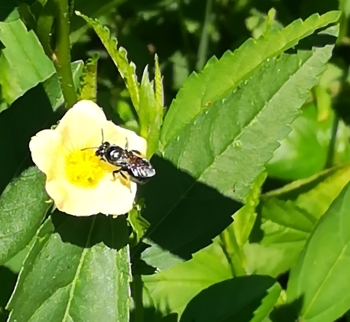
Sida acuta
Common name: wire weed (Eng.)
Woody herb with erect, long branches, up to 1.3 m tall; leaves are elongate with acute apices (lanceolate), glabrous to lightly hairy. Its flowers are pale and golden-yellow. Their sepals and fruit lack hairs. In South Africa, it is present in KwaZulu-Natal, Mpumalanga and Limpopo. Its occurrence is sparse, in open habitats along the road sides and disturbed areas. Also found in Swaziland and Namibia as well as eastern and central parts of Africa.
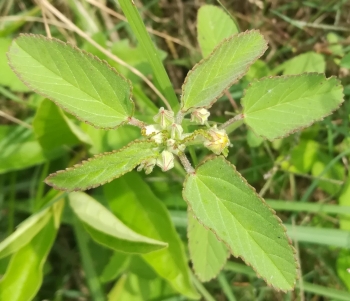
Sida alba
Common names: spiny sida, spring sida (Eng.); lente sida, stekeltaaiman (Afr.); sindanibita (Ven.)
Woody herb, stems branching from base, up to 0.75 m tall. Leaves are narrowly ovate or oblong. Flowers are solitary or in clusters in the leaf axils, white to pale yellow. In South Africa, it is present in KwaZulu-Natal, Gauteng, Limpopo, Mpumalanga and North West, where it grows in open areas in disturbed and cultivated land. Extends northwards into tropical and north Africa.
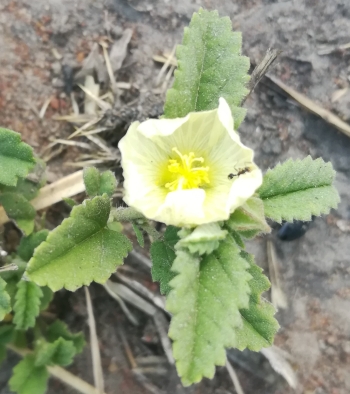
Sida chrysantha
Common name: golden sida (Eng.)
Much-branched, woody herb, up to 0.6 m tall. Stems usually slender and wiry. Leaves discolourous, oval-oblong, rounded to subacute at apex. Flowers solitary in leaf axils, pale or deep yellow to orange. In South Africa, it is distributed in the Northern and Eastern Cape, KwaZulu-Natal, Free State, Gauteng, Mpumalanga, Limpopo and North West. Also occurs in Botswana and Namibia, and in tropical Africa.
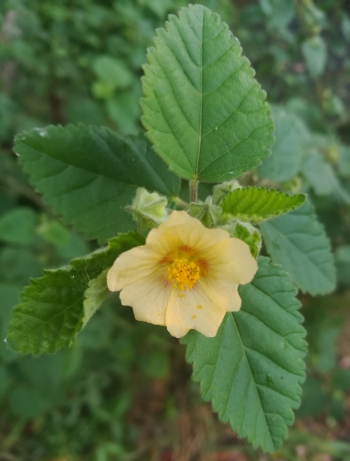
Sida cordifolia
Common names: flannel weed, koek fruit, white burr (Eng.); hartblaartaaiman, inama, koekbessie, koekbessiebossie, koekbossie, verdompsterk (Afr).
Tall subshrub, up to 1 m tall, having broad or heart-shaped (cordate) leaves with round tips, rough in texture because of the dense, small white hairs on both leaf surfaces. Flowers in small, dense clusters, bright yellow and orange, and sepals densely hairy. In most of South Africa and extending into tropical Africa. Found in disturbed soils in dry patches.
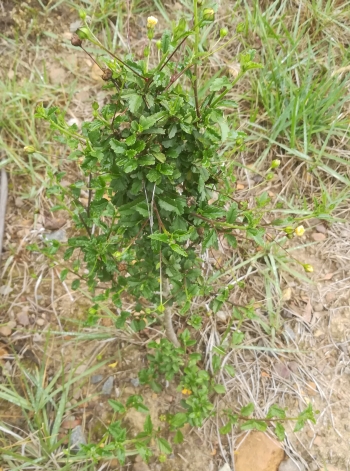
Sida dregei
Common names: sutherland’s curse, spider leg (Eng.)
Woody herb; branches erect, up to 1 m tall, young ones stiff and wiry. Leaves are ovate or lance-shaped, apex narrowed and acute. Inflorescence showy because of its long pedicels, flowers solitary in leaf axils, yellow to orange. In South Africa, the species occurs in the Western and Eastern Cape, KwaZulu-Natal, Free State, Gauteng, Mpumalanga, Limpopo and North West. It is found in road side bushes, forest margins or in between rocks. Also in Botswana, Namibia and Swaziland.
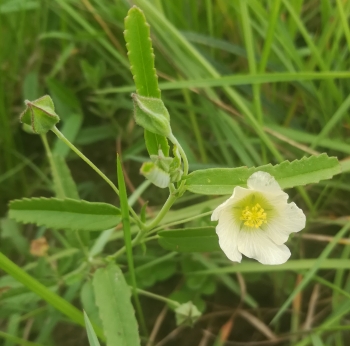
Sida ovata
Common names: mapungubwe sida (Eng.); umdiza wethafa (Zul.)
Low-growing, woody herb, up to 0.5 m high; densely grey- or grey-green-tomentose stems; wiry when young. Leaves oval or oblong or lance-shaped, apex obtuse or rounded. Flowers solitary in leaf axils or sometimes 2 or 3 flowers, white or yellow. In South Africa, it is distributed in the Northern Cape, Mpumalanga, Limpopo and North West. This species prefers dry habitats. Also in Namibia and northwards into tropical Africa.
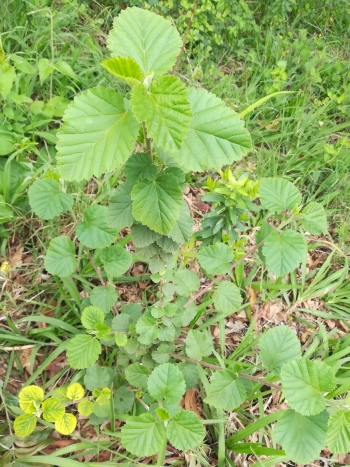
Sida pseudocordifolia
Common name: flannel weed (Eng.)
Tall subshrub, with erect branches up to 1.2 m tall, having heart-shaped leaves and orange-yellow flowers, closely resembling S. cordifolia. Has 8 to 10 mericarps in fruit capsules, compared to 10 to 12 mericarps in S. cordifolia. Less common than S. cordifolia. It is distributed in KwaZulu-Natal, Mpumalanga and North West. Grows on hill slopes.
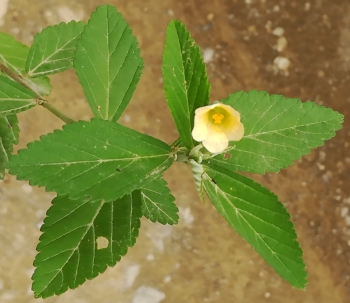
Sida rhombifolia
Common names: arrowleaf sida, common sida, rhombus-leaved sida, queenslandhemp (Eng.); pretoria sida, pretoria bossie, smalblaartaaiman, taaiman (Afr.)
Tall subshrub, erect branches up to 1 m tall, having oval, lanceolate or diamond-(rhomboid)shaped, with round tips covered with hairs, more so on lower surface. Its flowers are solitary on thin, long pedicels, white or pale yellow. Their sepals are sparsely hairy. This is the most widespread species, occurring throughout South Africa and into tropical Africa and on other continents. It is weedy and common along road sides and disturbed areas. It is also the most variable species, with several varieties in S. rhombifolia and varieties riparia and rhombifolia occur in South Africa. Recently S. serratifolia from the Limpopo Province and Swaziland was reduced to a variety in S. rhombifolia.
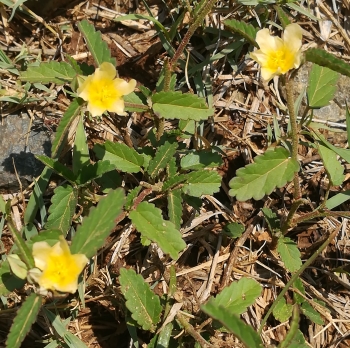
Sida spinosa
Common names: prickly sida, spiny sida, prickly fan petals (Eng.)
Woody herb, with erect branches up to 0.6 m tall and elongated to broad oval leaves with pointed or blunt tips and sometime becomes purplish red on the margins. Its flowers are solitary or in small clusters, white or pale yellow. Their sepals are finely hairy. The species grows in open dry areas. In South Africa, S. spinosa occurs in KwaZulu-Natal, Free State, Gauteng, Mpumalanga and North West. Also occurs in Madagascar.
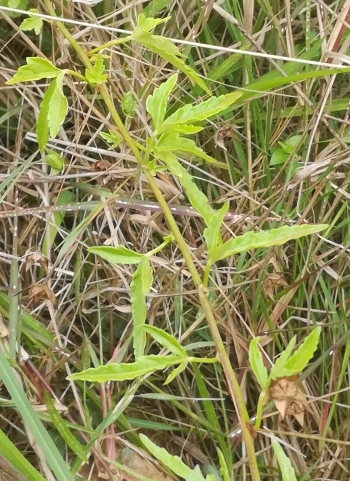
Sida ternata
Common name: three-leaved sida (Eng.)
Includes S. triloba, named for its tri-lobed leaves, a rare and diagnostic character among species of Sida. Small, woody herb; stems erect, soft up to 0.75 m. Flowers are white or pale yellow, borne on long pedicels (± 60 mm) on each leaf axil towards the apex and sometimes clustered on stem apices. The species is distributed in Eastern Cape, KwaZulu-Natal, Free State, Gauteng, Mpumalanga and Limpopo. Grows in thicket margins and prefers partial shade.
References
- Exell, A. & Wild, H. 1961. Malvaceae. Flora zambesiaca: Mozambique, Federation of Rhodesia and Nyasaland, Bechuanaland Protectorate 1: 481, 482. Kew, London.
- Gibson, J.M. 1975. Wild flowers of Natal: coastal region. Trustees of the Natal Publishing Trust Fund, Durban.
- Jain, A., Choubey, S., Singour, P.K., Rajak, H. & Pawar, R.S. 2011. Sida cordifolia (Linn) – an overview. Journal of Applied Pharmaceutical Science 1: 23–31.
- Leistner, O.A. (ed.). 2000. Seed plants of southern Africa: families and genera. Strelitzia 10. National Botanical Institute, Pretoria.
- Long, G. (ed.). 1841. Sida. The penny cyclopedia of the society for the diffusion of useful knowledge. Volume 21. Pp. 490.
- Pooley, E. 2005. A field guide to wild flowers KwaZulu-Natal and the eastern regions. The Flora Publications Trust, Durban.
- Raju, A.J.S. & Rani, D.S. 2016. Pollination ecology of S. acuta, S. cordata and S. cordifolia (Malvaceae). Phytologia Balcanica 22: 363–376.
Credits
Yashica Singh & Sushant Sharma
KwaZulu-Natal Herbarium
February 2018
Acknowledgements: Prof. Himansu Baijnath is thanked for images of Sida acuta, S.cordifolia and S. rhombifolia. All other images by S.Sharma.
Plant Attributes:
Plant Type:
SA Distribution:
Soil type:
Flowering season:
PH:
Flower colour:
Aspect:
Gardening skill:
Special Features:
Horticultural zones






Rate this article
Article well written and informative
Rate this plant
Is this an interesting plant?
Login to add your Comment
Back to topNot registered yet? Click here to register.